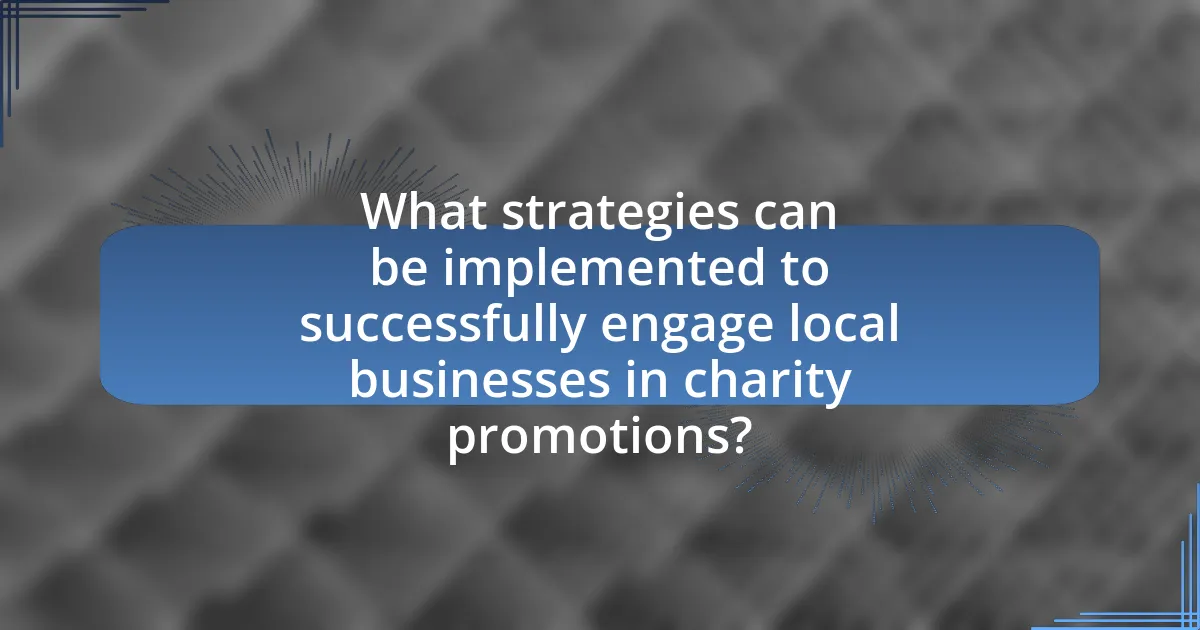The article focuses on building partnerships between local businesses and charities for effective promotional strategies. It outlines key elements such as mutual benefits, clear communication, and shared goals that are essential for successful collaborations. The benefits for local businesses include enhanced brand image, increased customer loyalty, and potential financial incentives like tax breaks. Various partnership types, including sponsorships and cause-related marketing, are discussed, along with strategies for initiating and maintaining these relationships. The importance of trust, community engagement, and effective communication in fostering long-term partnerships is emphasized throughout the article.

What are the key elements of building partnerships with local businesses for charity promotions?
The key elements of building partnerships with local businesses for charity promotions include mutual benefit, clear communication, and shared goals. Establishing a partnership requires identifying how both the charity and the business can gain from the collaboration, such as increased visibility for the business and funding or support for the charity. Effective communication ensures that both parties understand their roles, expectations, and the promotional strategies involved. Additionally, aligning on shared goals, such as community impact or fundraising targets, fosters a collaborative spirit and strengthens the partnership. These elements are essential for creating successful and sustainable charity promotions that engage the local community.
How can local businesses benefit from partnering with charities?
Local businesses can benefit from partnering with charities by enhancing their brand image and increasing customer loyalty. Collaborating with charities allows businesses to demonstrate social responsibility, which can attract customers who prioritize ethical consumption. According to a 2019 study by Cone Communications, 87% of consumers are more likely to purchase a product from a company that supports a cause they care about. Additionally, partnerships can lead to increased visibility through joint marketing efforts, community events, and social media exposure, further driving customer engagement and sales.
What are the potential financial incentives for local businesses?
Local businesses can benefit from several potential financial incentives, including tax breaks, grants, and increased customer traffic. Tax incentives, such as deductions or credits for charitable contributions, can reduce a business’s overall tax liability, encouraging them to engage in community-focused initiatives. Additionally, local governments and nonprofit organizations often offer grants to support businesses that partner with charities, providing direct financial support for promotional activities. Furthermore, collaborating with charities can enhance a business’s visibility and reputation, leading to increased customer traffic and sales, as consumers are more likely to support businesses that contribute to social causes.
How does community engagement enhance a business’s reputation?
Community engagement enhances a business’s reputation by fostering trust and goodwill within the local community. When a business actively participates in community initiatives, such as charity events or local sponsorships, it demonstrates a commitment to social responsibility, which can lead to increased customer loyalty. Research indicates that 70% of consumers prefer to buy from companies that support social causes, highlighting the positive impact of community involvement on public perception. Additionally, businesses that engage with their communities often receive positive media coverage, further solidifying their reputation as responsible and caring entities.
What types of partnerships can be formed between charities and local businesses?
Charities and local businesses can form several types of partnerships, including sponsorships, cause-related marketing, in-kind donations, and employee engagement programs. Sponsorships involve businesses providing financial support for charity events in exchange for brand visibility. Cause-related marketing links a business’s sales to a charity, where a portion of profits is donated to the charity based on sales performance. In-kind donations consist of goods or services provided by businesses to charities, which can help reduce operational costs for the charity. Employee engagement programs encourage businesses to involve their employees in volunteer activities or fundraising efforts for charities, fostering community involvement and enhancing employee morale. These partnership types are effective in leveraging resources and enhancing community impact.
What are the differences between sponsorships and collaborations?
Sponsorships and collaborations differ primarily in their structure and objectives. Sponsorships involve a financial or resource investment by one party, typically a business, to support an event, activity, or organization in exchange for brand visibility and marketing benefits. For example, a company may sponsor a charity event, providing funds in return for logo placement and promotional opportunities. In contrast, collaborations are partnerships where two or more parties work together towards a common goal, sharing resources, expertise, and responsibilities without a primary focus on financial gain. An example of collaboration is a charity partnering with a local business to co-host an event, where both parties contribute equally to planning and execution. This distinction highlights that sponsorships are often transactional, while collaborations are more relational and cooperative.
How can businesses contribute through in-kind donations?
Businesses can contribute through in-kind donations by providing goods or services instead of cash to support charitable organizations. This form of contribution can include donating products, offering professional services, or providing venue space for events. For instance, a restaurant may donate meals for a charity event, while a marketing firm might offer pro bono services to help promote a nonprofit’s mission. In-kind donations not only help organizations reduce operational costs but also enhance community engagement and strengthen relationships between businesses and local charities.

Why is it important to establish strong relationships with local businesses for charity promotions?
Establishing strong relationships with local businesses for charity promotions is crucial because it enhances visibility and credibility for the charity. When local businesses collaborate with charities, they leverage their established customer base, which can significantly increase awareness and participation in charitable events. For instance, a study by the Charitable Giving Report indicated that 70% of consumers are more likely to support a charity that is endorsed by a local business they trust. This partnership not only drives donations but also fosters community engagement, as local businesses often have a vested interest in the welfare of their community.
What role does trust play in these partnerships?
Trust is fundamental in partnerships between charities and local businesses, as it fosters collaboration and mutual benefit. When charities trust local businesses, they are more likely to engage in open communication, share resources, and align their goals, which enhances the effectiveness of promotional efforts. Research indicates that trust leads to increased commitment and cooperation, essential for successful partnerships. For instance, a study published in the Journal of Business Research found that trust significantly influences the quality of collaboration in business partnerships, ultimately impacting the success of joint initiatives.
How can charities build trust with local businesses?
Charities can build trust with local businesses by demonstrating transparency and accountability in their operations. Establishing clear communication about goals, financials, and the impact of donations fosters a sense of reliability. For instance, charities that provide regular updates on how funds are utilized and share success stories can enhance credibility. According to a study by the Charities Aid Foundation, 70% of businesses are more likely to partner with charities that show clear evidence of their impact, highlighting the importance of measurable outcomes in building trust.
What are the long-term benefits of maintaining these relationships?
Maintaining relationships with local businesses for charity promotions yields long-term benefits such as increased community support and enhanced brand reputation. These partnerships foster a sense of trust and loyalty among community members, as businesses that engage in charitable activities are often viewed more favorably. Research indicates that 70% of consumers prefer to buy from brands that support social causes, demonstrating that such relationships can lead to increased customer retention and sales. Additionally, sustained collaborations can result in shared resources and networks, amplifying the impact of charitable initiatives and creating a more robust community presence.
How can effective communication enhance partnerships?
Effective communication enhances partnerships by fostering trust, clarity, and collaboration among stakeholders. When partners communicate effectively, they can share goals, expectations, and feedback openly, which leads to a more aligned and productive relationship. Research indicates that organizations with strong communication practices experience a 25% increase in partnership satisfaction, as clear dialogue reduces misunderstandings and conflicts. Furthermore, effective communication allows for the timely exchange of information, enabling partners to respond quickly to challenges and opportunities, ultimately driving the success of collaborative initiatives such as charity promotions.
What communication strategies should charities employ with local businesses?
Charities should employ relationship-building communication strategies with local businesses to foster partnerships. Establishing regular, transparent communication channels, such as newsletters and meetings, allows charities to share their mission and impact effectively. Utilizing social media platforms to highlight collaborative efforts can enhance visibility and engagement, as evidenced by a 2021 study from the Charitable Giving Report, which found that 70% of businesses prefer to partner with charities that actively promote their initiatives online. Additionally, personalized outreach, including tailored proposals that align the charity’s goals with the business’s values, can significantly increase the likelihood of collaboration.
How can feedback improve partnership outcomes?
Feedback can improve partnership outcomes by facilitating open communication and aligning goals between partners. When partners actively solicit and incorporate feedback, they can identify areas for improvement, enhance collaboration, and ensure that both parties are working towards shared objectives. Research indicates that organizations that engage in regular feedback mechanisms experience a 14.9% increase in performance, as highlighted in a study by the Harvard Business Review. This demonstrates that effective feedback not only strengthens relationships but also drives better results in partnership initiatives.

What strategies can be implemented to successfully engage local businesses in charity promotions?
To successfully engage local businesses in charity promotions, organizations should implement collaborative marketing strategies that highlight mutual benefits. By creating joint promotional campaigns, businesses can enhance their visibility while supporting a charitable cause, which can lead to increased customer loyalty and community goodwill. For instance, a study by the Charitable Giving Report indicates that 70% of consumers prefer to buy from companies that support local charities, demonstrating the potential for increased sales through such partnerships. Additionally, offering recognition through social media shout-outs or featuring businesses in promotional materials can incentivize participation, as businesses often seek positive exposure in their communities.
How can charities identify potential business partners?
Charities can identify potential business partners by conducting market research to pinpoint local businesses that align with their mission and values. This involves analyzing community demographics, identifying businesses that share similar target audiences, and assessing their corporate social responsibility initiatives. For instance, a charity focused on environmental conservation may seek partnerships with local eco-friendly businesses, as these entities are likely to be interested in supporting related causes. Additionally, charities can leverage networking events, social media platforms, and local business directories to connect with potential partners. Engaging in community events and collaborating on initiatives can also help charities establish relationships with businesses that are open to partnership opportunities.
What criteria should be used to evaluate potential partnerships?
To evaluate potential partnerships for charity promotions with local businesses, the criteria should include alignment of values, mutual benefits, and community impact. Alignment of values ensures that both the charity and the business share similar missions and ethics, which fosters a genuine partnership. Mutual benefits refer to the advantages each party gains, such as increased visibility for the business and funding or resources for the charity. Community impact assesses how the partnership will positively affect the local community, which is crucial for both entities’ reputations and effectiveness. These criteria are essential for establishing successful and sustainable partnerships that resonate with stakeholders and the community.
How can market research assist in finding suitable local businesses?
Market research assists in finding suitable local businesses by identifying consumer preferences, market trends, and competitive landscapes. This process involves collecting data on local demographics, purchasing behaviors, and the performance of existing businesses in the area. For instance, a study by the Small Business Administration indicates that 70% of consumers prefer to support local businesses, highlighting the importance of understanding local market dynamics. By analyzing this data, organizations can pinpoint businesses that align with their charity’s mission and values, ensuring effective partnerships for promotions.
What are some best practices for initiating partnerships with local businesses?
To initiate partnerships with local businesses effectively, organizations should first identify businesses that align with their mission and values. This alignment fosters a shared purpose, making collaboration more appealing. Next, organizations should approach potential partners with a clear proposal that outlines mutual benefits, such as increased visibility and community goodwill. Research indicates that partnerships with local businesses can enhance fundraising efforts by up to 30%, as businesses often have established customer bases that can be leveraged for charitable causes. Additionally, maintaining open communication and being flexible in negotiations can strengthen the partnership, ensuring both parties feel valued and engaged.
How should charities approach local businesses for collaboration?
Charities should approach local businesses for collaboration by clearly articulating mutual benefits and aligning their missions. Establishing a connection begins with research to identify businesses that share similar values or community goals. Charities can then initiate contact through personalized outreach, such as emails or meetings, to present specific collaboration ideas that highlight how the partnership can enhance the business’s community engagement and visibility.
For instance, a charity might propose a co-hosted event that not only raises funds but also attracts customers to the business, thereby increasing foot traffic. According to a study by the Charitable Giving Coalition, 70% of consumers prefer to support businesses that contribute to local charities, indicating that such collaborations can enhance a business’s reputation and customer loyalty.
What materials or proposals can help in making a compelling case?
To make a compelling case for building partnerships with local businesses for charity promotions, a well-structured proposal that includes data-driven insights, case studies, and clear benefits is essential. Specifically, including statistics on community engagement and the positive impact of local business involvement in charitable activities can strengthen the argument. For example, research from the National Philanthropic Trust indicates that 70% of consumers are more likely to support businesses that engage in charitable giving, demonstrating the potential for increased customer loyalty and sales. Additionally, presenting testimonials from previous successful partnerships can provide concrete evidence of the benefits, showcasing how collaboration can enhance brand reputation and community relations.
What are practical tips for maintaining successful partnerships?
To maintain successful partnerships, establish clear communication and set mutual goals. Clear communication ensures that all parties understand expectations, responsibilities, and timelines, which is crucial for collaboration. Setting mutual goals aligns the interests of both partners, fostering a sense of shared purpose. Research indicates that partnerships with defined objectives are 30% more likely to succeed, as they provide a framework for accountability and progress tracking. Regular check-ins and feedback loops further enhance relationship dynamics, allowing for adjustments and reinforcing commitment.
How can regular updates and engagement sustain interest from local businesses?
Regular updates and engagement can sustain interest from local businesses by fostering a continuous connection and demonstrating ongoing value. When businesses receive consistent communication about charity initiatives, they feel more involved and invested in the partnership. This engagement can include sharing success stories, providing updates on fundraising progress, and highlighting the impact of their contributions. Research indicates that businesses are more likely to maintain partnerships when they see tangible results and benefits, such as increased community visibility and positive brand association. For instance, a study by the Charitable Giving Report found that 70% of businesses reported a stronger commitment to partnerships that included regular updates and engagement strategies.
What methods can be used to celebrate and acknowledge business contributions?
Methods to celebrate and acknowledge business contributions include public recognition, awards, and collaborative events. Public recognition can occur through social media shout-outs, press releases, or features in newsletters, which highlight the contributions of local businesses to charity promotions. Awards can be presented during community events or ceremonies, providing formal acknowledgment of their support and impact. Collaborative events, such as charity fundraisers or community service days, allow businesses to participate actively while being recognized for their contributions, fostering a sense of community and partnership. These methods not only honor the businesses but also encourage ongoing support and engagement in charitable activities.


